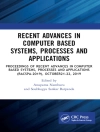In high power, high voltage electronics systems, a strategy to
manage short timescale energy imbalances is fundamental to the
system reliability. Without a theoretical framework, harmful local
convergence of energy can affect the dynamic process of
transformation, transmission, and storage which create an
unreliable system.
With an original approach that encourages understanding of both
macroscopic and microscopic factors, the authors offer a solution.
They demonstrate the essential theory and methodology for the
design, modeling and prototyping of modern power electronics
converters to create highly effective systems. Current applications
such as renewable energy systems and hybrid electric vehicles are
discussed in detail by the authors.
Key features:
* offers a logical guide that is widely applicable to power
electronics across power supplies, renewable energy systems, and
many other areas
* analyses the short-scale (nano-micro second) transient
phenomena and the transient processes in nearly all major
timescales, from device switching processes at the nanoscale level,
to thermal and mechanical processes at second level
* explores transient causes and shows how to correct them by
changing the control algorithm or peripheral circuit
* includes two case studies on power electronics in hybrid
electric vehicles and renewable energy systems
Practitioners in major power electronic companies will benefit
from this reference, especially design engineers aiming for optimal
system performance. It will also be of value to faculty staff and
graduate students specializing in power electronics within
academia.
Innehållsförteckning
About the authors
Preface
1. Power Electronic Device, Circuit, Topology, and Control
1.1 Power Electronics
1.2 The Evolution of Power Device Technology
1.3 Power Electronic Circuit Topology
1.4 PWM Control
1.5 Typical Power Electronic Converters and Their Applications
1.6 Transient Processes in Power Electronics and Book Organization
References
2. Macroscopic and Microscopic Factors in Power Electronic System
2.1 Introduction
2.2 Microelectronics vs. Power Electronics
2.3 State-of-the-Art Of Research in Short-Timescale Transients
2.4 Typical Influential Factors and Transient Processes
2.5 Methods to Study the Short-Timescale Transients
2.6 Summary
References
3. Power Semiconductor Devices, Integrated Power Circuits, and Their Short Time Scale Transients
3.1 Major Characteristics of Semiconductors
3.2 Modeling Methods of Semiconductors
3.3 IGBT
3.4 IGCT
3.5 Silicon Carbide JFET
3.6 System-Level SOA
3.7 Soft-Switching Control and Its Application in High Power Converters
References
4. Power Electronics in Electric and Hybrid Vehicles
4.1 Introduction to Electric and Hybrid Vehicles
4.2 Architecture and Control of Hybrid Electric Vehicles
4.3 Power Electronics In HEVs
4.4 Battery Chargers For EV And PPEV
References
5. Power Electronics in Alternative Energy and Advanced Power Systems
5.1 Typical Alternative Energy Systems
5.2 Transients in Alternative Energy Systems
5.3 Power Electronics, Alternative Energy and Future Micro-Grid Systems
5.4 Dynamic Process in the Multi-Source System
5.5 Specialty of Control and Analyzing Methods in Alternative Energy Systems
5.6 Application of Power Electronics in Electric Power System
References
6. Power Electronics in Battery Management Systems
6.1 Application of Power Electronics in Rechargeable Batteries
6.2 Battery Charge Management
6.3 Cell Balancing
6.4 Safe Operating Area of Battery Power Electronics
References
7. Dead-band Effect and Minimum Pulse Width
7.1 Dead-Band Effect in DC-AC Inverters
7.2 Dead-Band Effect in DC-DC Converter
7.3 Control Strategy for Dead-Band Compensation
7.4 Minimum Pulse Width
7.5 Summary
8. Modulated Error in Power Electronic System
8.1 Modulated Error Between Information Flow and Power Flow
8.2 Modulated Error in Switching Power Semiconductors
8.3 Modulated Error in DC-AC Inverter
8.4 Modulated Error in The DC-DC Converter
8.5 Summary
9. Future Trends
10. Index
Om författaren
Hua Bai, University of Michigan-Dearborn, USA
Dr Hua Bai received B.S. and Ph.D degrees in Electrical Engineering from Tsinghua University, Beijing, China in 2002 and 2007, respectively. He joined the University of Michigan-Dearborn in September 2007 as a post-doctoral researcher. His research interests are the short-timescale pulsed power phenomena of power electronic devices in three-level NPC high voltage and high power inverter, and integrated design of high voltage and high power bidirectional DC-DC converters.
Chris Mi, University of Michigan-Dearborn, USA
Dr. Chris Mi is Associate Professor of Electrical and Computer Engineering at the University of Michigan, Dearborn. Dr. Mi holds a BS and an MS degree from Northwestern Polytechnical University, Xi’an, China, and a Ph.D degree from the University of Toronto, Toronto, Canada. Dr. Mi is the recipient of the ’National Innovation Award, ’ ’Government Special Allowance’ given by the Chinese Central Government, the ’Distinguished Teaching Award’ of University of Michigan Dearborn. He is also a recipient of the 2007 IEEE Region 4 ’Outstanding Engineer Award, ’ 2007 ’IEEE Southeastern Michigan Section Outstanding Professional Award, ’ and 2007 SAE ’Environmental Excellence in Transportation Award.’ Dr. Mi is the General Chair of IEEE Vehicle Power and Propulsion Conference 09.












